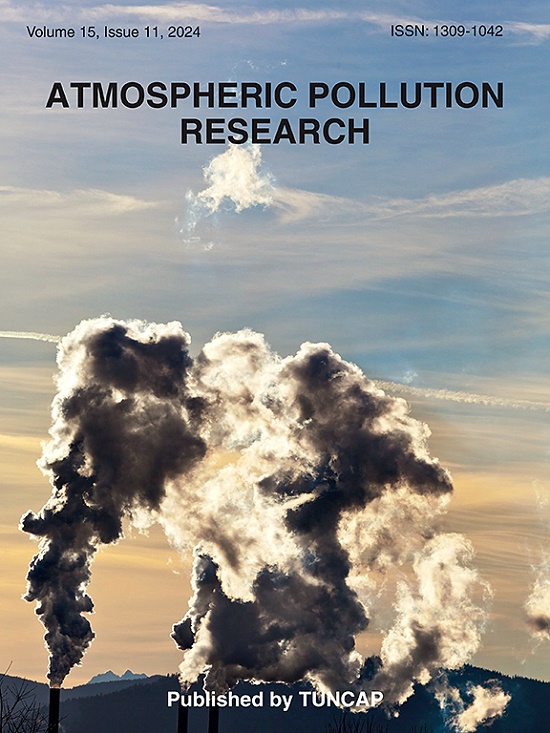二次照明光源的碳质气溶胶排放:排放系数和光学特性
IF 3.9
3区 环境科学与生态学
Q2 ENVIRONMENTAL SCIENCES
引用次数: 0
摘要
印度正在转向使用更清洁的民用燃料,但这一转变并没有完全解决家庭照明的挑战。电力中断,尤其是在农村地区,导致人们使用煤油灯、食用油灯和蜡烛等二次照明光源。我们之前的研究发现,煤油灯芯和飓风灯是印度家庭的主要二次照明光源。本研究利用实验室抽气橱系统测量了印度五种主要二次照明设备产生的碳质气溶胶的排放因子(EF)和光学特性。主要的二次照明设备,如简易灯芯灯(61.4 ± 9.8 g kg-1)和飓风灯(17.2 ± 4.8 g kg-1),显示出比典型的住宅生物质燃烧更高的碳元素(EC)排放系数。主要在印度排灯节期间使用的芝麻油灯也有很大的碳元素排放潜力,其碳元素 EF 为 71.6 ± 16.9 g kg-1。近紫外波长的吸收角指数(AAE)较低,为 1 ∼ 1,这表明黑碳(BC)占主导地位,褐碳的吸收可忽略不计,有机碳浓度很低也证实了这一点。全印度居民煤油照明产生的EC排放量(12.5千兆克/年-1)显示,印度东部的EC排放量较高(∼50%)。此外,排灯节期间使用油灯可在两天内排放 3 千兆克氨基甲酸乙酯。这些测量的EFs、气溶胶光学特性和估计的排放量将有助于未来的研究更准确地得出这些被忽视的照明设备对气候和健康的影响。本文章由计算机程序翻译,如有差异,请以英文原文为准。
Carbonaceous aerosol emissions from secondary lighting sources: Emission factors and optical properties
India is shifting towards cleaner residential fuels, but this transition does not fully address household lighting challenges. Power disruptions, especially in rural areas, lead to the use of secondary lighting sources such as kerosene lamps, edible oil lamps, and candles. Our previous work identified kerosene wick and hurricane lamps as major secondary lighting sources in Indian households. This study presents the emission factors (EF) and optical properties of carbonaceous aerosols from five major secondary lighting devices in India, measured using a laboratory extractor hood system. Dominant secondary lighting devices, such as simple wick lamps (61.4 ± 9.8 g kg⁻1) and hurricane lamps (17.2 ± 4.8 g kg⁻1), exhibit higher elemental carbon (EC) EFs than typical residential biomass burning. Sesame oil lamps, primarily used in India during the Diwali festival, also have significant EC emission potential, with an EC EF of 71.6 ± 16.9 g kg⁻1. The low absorption Angstrom exponent (AAE) of ∼1 at near-UV wavelengths indicates a dominance of black carbon (BC) and negligible brown carbon absorption, corroborated by very low organic carbon concentrations. India-wide EC emissions (12.5 Gg year⁻1) from residential kerosene lighting show a higher (∼50%) contribution from eastern India. Additionally, the use of oil lamps during the Diwali festival could emit ∼3 Gg of EC in two days, with a potential reduction of ∼90% if wax-based lamps replace oil lamps. These measured EFs, aerosol optical properties, and estimated emissions will help future studies derive more accurate climate and health impacts from these otherwise overlooked lighting devices.
求助全文
通过发布文献求助,成功后即可免费获取论文全文。
去求助
来源期刊

Atmospheric Pollution Research
ENVIRONMENTAL SCIENCES-
CiteScore
8.30
自引率
6.70%
发文量
256
审稿时长
36 days
期刊介绍:
Atmospheric Pollution Research (APR) is an international journal designed for the publication of articles on air pollution. Papers should present novel experimental results, theory and modeling of air pollution on local, regional, or global scales. Areas covered are research on inorganic, organic, and persistent organic air pollutants, air quality monitoring, air quality management, atmospheric dispersion and transport, air-surface (soil, water, and vegetation) exchange of pollutants, dry and wet deposition, indoor air quality, exposure assessment, health effects, satellite measurements, natural emissions, atmospheric chemistry, greenhouse gases, and effects on climate change.
 求助内容:
求助内容: 应助结果提醒方式:
应助结果提醒方式:


